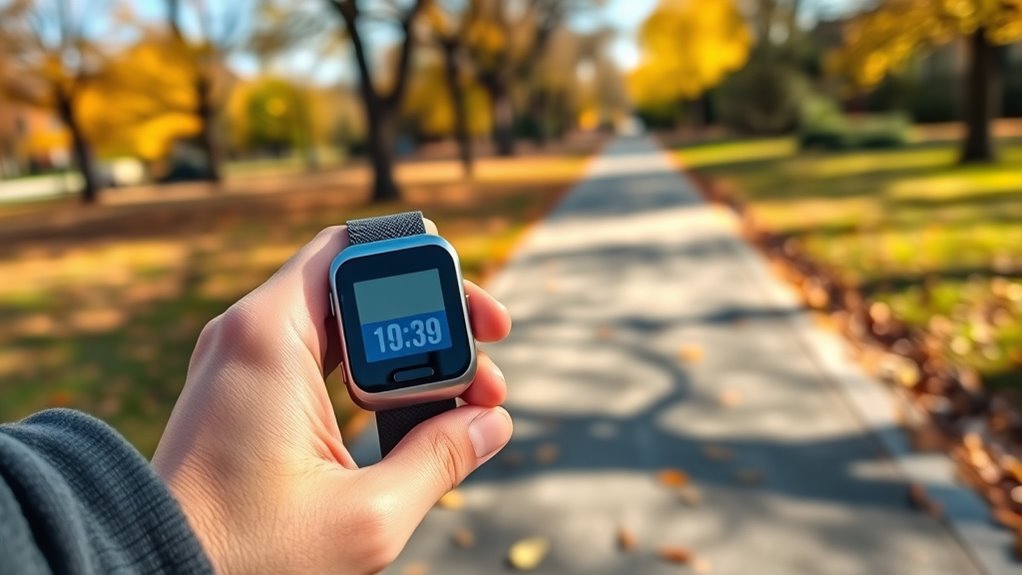To set realistic daily step goals, consider your current activity level and daily routines. Start with small targets, like 3,000 to 5,000 steps, and gradually increase as your fitness improves. Track your progress consistently and celebrate milestones to stay motivated. Adjust your goals based on your lifestyle and how you feel. If you’d like tips on choosing the right device and keeping motivated, there’s more to explore.
Key Takeaways
- Start with achievable goals like 3,000–5,000 steps daily if sedentary.
- Personalize targets based on your current activity levels and lifestyle.
- Increase step goals gradually as fitness and consistency improve.
- Use regular tracking to set realistic milestones and maintain motivation.
- Incorporate daily routines, such as taking stairs or walking during breaks, to reach goals.
Choosing the Right Pedometer for Your Needs

When selecting a pedometer, it’s important to contemplate your specific fitness goals and daily routine. Pedometer accuracy varies across models, so choose one that reliably tracks your steps without overestimating or underestimating. Wearable technology has advanced, offering features like calorie counting, distance measurement, and syncing capabilities with smartphones or fitness apps. Consider whether you prefer a simple device or one with extra functionalities to stay motivated. Lightweight and comfortable wearability ensures you’ll actually use it consistently. Look for models with good reviews for accuracy and durability. Your choice should align with your activity level and how much detail you want from your tracking. By selecting a device suited to your needs, you’ll stay motivated and accurately monitor your progress. Remote work can also influence your daily activity levels, so choosing a pedometer that encourages movement can support overall health.
How to Properly Wear and Use Your Pedometer

Once you’ve chosen the right pedometer for your needs, it’s important to wear it correctly to guarantee accurate tracking. The wearing position is vital—most devices work best when clipped to your waistband or placed in your pocket, close to your hips. Avoid wearing it on your shoes or in bags, as this can lead to inaccurate step counts. Consistent placement helps ensure reliable readings. Additionally, proper device maintenance is essential; keep your pedometer clean, free of dust, and check the battery regularly to prevent malfunctions. Avoid exposing it to moisture or extreme temperatures. By paying attention to how you wear and care for your pedometer, you’ll improve its accuracy and get the most reliable data to track your daily activity effectively. Regularly calibrating your pedometer can also help maintain its accuracy over time.
Setting Personalized Step Goals Based on Your Lifestyle

To create effective step goals, you should consider your current activity level, daily routines, and fitness objectives. Your personalized fitness plan works best when your goals align with what you already do each day. If your routines involve mostly sitting, start with a modest increase, like 3,000 to 5,000 steps daily. If you’re already active, set higher targets that challenge you without causing burnout. Think about how you spend your time—commuting, working, or exercising—and adjust your goals accordingly. Personalizing your step goals ensures they’re realistic and sustainable, helping you stay motivated. Focus on gradual progress that fits your lifestyle, making daily movement a natural part of your routine rather than a burdensome task. Incorporating personalized goals based on your activity level can significantly improve your adherence and enjoyment of a walking routine.
Adjusting Goals as Your Fitness Levels Improve

As your fitness level advances, it’s important to regularly reevaluate and adjust your step goals to continue making progress. Progress tracking helps you see how far you’ve come and highlights areas for improvement. When you notice increased stamina or consistency, consider setting higher, yet achievable, targets to stay challenged. Using motivational strategies like rewarding yourself for reaching new milestones can keep your momentum strong. Modifying your goals prevents plateaus and keeps your fitness journey engaging. Keep in mind that gradual increases are more sustainable and less discouraging. Regularly reviewing your step counts ensures your goals remain relevant and inspiring. Incorporating remote hackathons into your routine can introduce new tools and ideas to enhance your motivation and learning. Remember, small, consistent improvements lead to significant progress over time, making your efforts more rewarding and sustainable.
Incorporating Step Tracking Into Daily Routines
Integrating step tracking into your daily routines can seamlessly boost your activity levels without requiring extra time or effort. By making a habit of step counting throughout your day, you turn everyday activities into opportunities for fitness tracking. For example, park farther from your destination, use stairs instead of elevators, or take short walking breaks. Keep your pedometer visible as a reminder to stay active. Incorporate small goals, like reaching a certain number of steps before lunch or dinner. These simple adjustments help you stay aware of your movement and encourage consistent activity. Over time, tracking your steps becomes second nature, making it easier to meet your daily fitness goals without feeling overwhelmed. This approach keeps you motivated and engaged in your health journey.
Overcoming Common Challenges in Reaching Your Step Targets

Reaching your step targets can be challenging, especially when daily routines become busy or monotonous. To stay on track, try motivational strategies like setting small, achievable goals and rewarding yourself. Social accountability also helps—find a walking buddy or join a group to keep you motivated. Consider the following common challenges and solutions:
| Challenge | Solution | Benefit |
|---|---|---|
| Busy schedule | Schedule short walks during breaks | Maintains consistency |
| Boredom with routine | Vary your routes or times | Keeps walking engaging |
| Lack of motivation | Use social accountability | Encourages persistence |
| Weather restrictions | Indoor activities or treadmill | Ensures steady progress |
| Feeling unmotivated | Celebrate small wins | Boosts confidence |
Additionally, incorporating innovative materials like lightweight, comfortable shoes can make walking more enjoyable and sustainable.
Celebrating Milestones and Staying Motivated

Celebrating your milestones keeps you motivated and reinforces your commitment to staying active. Recognizing progress boosts your confidence and fuels your desire to reach new goals. Implementing a reward system can make this process even more rewarding, whether it’s treating yourself to something special or enjoying extra rest days. You can also keep your spirits high by using motivational quotes that resonate with your journey. To deepen your motivation, consider these strategies:
- Set small, achievable goals to mark each milestone, making progress tangible.
- Share your achievements with friends or family for accountability and encouragement.
- Reflect on your growth regularly, noting how far you’ve come and adjusting your goals accordingly.
- Regularly assess and rotate items to prevent clutter buildup and keep your space organized, which can also boost your mental clarity.
Celebrating these wins keeps your momentum strong and your focus clear.
Frequently Asked Questions
How Accurate Are Basic Pedometers Compared to Advanced Fitness Trackers?
Basic pedometers can be quite accurate, but their reliability depends on device calibration and sensor technology. While advanced fitness trackers often have more sophisticated sensors for better accuracy, simple pedometers may miss some steps or count false ones if not properly calibrated. You should regularly check your device’s calibration and understand its sensor limitations to get the most accurate step count possible.
Can Pedometers Track Activities Other Than Walking or Running?
They say “don’t put all your eggs in one basket,” and that’s true for activity tracking too. Pedometers mainly focus on walking or running, so their activity variety is limited. They can’t accurately track activities like cycling, swimming, or strength training, highlighting their limitations. If you want a full picture of your activity, consider a device that captures various movements beyond just steps.
What Is the Ideal Daily Step Goal for Different Age Groups?
You should consider age-specific recommendations and activity level considerations when setting your daily step goal. For example, adults often aim for 10,000 steps, while older adults might target around 7,000 to 8,000. Kids and teenagers usually need more active time, so goals vary. Adjust your steps based on your health, lifestyle, and fitness level to stay motivated and achieve realistic, personalized progress.
How Do Weather Conditions Affect Step Tracking Accuracy?
Weather interference can impact your step tracking accuracy, especially if rain, snow, or strong winds cause your device to misread steps. Cold weather might make you less active, reducing step count, while high humidity could affect device sensitivity. To get the most accurate results, keep your pedometer sheltered from the elements and guarantee it’s properly calibrated. Remember, harsh weather conditions can lead to under- or over-counting your steps.
Are There Health Risks Associated With Setting Too High Step Goals?
Imagine your body as a finely tuned machine—pushing it too hard can cause breakdowns. Setting a step goal overload might seem motivating, but it raises injury risk and health concerns. You could strain muscles or joints, risking overuse injuries. Always listen to your body and increase steps gradually. Aiming too high too fast may backfire, so find a balance that challenges you without compromising your well-being.
Conclusion
Now that you know how to set realistic goals and track your steps effectively, the real challenge begins. Will you stay motivated as your routine gets busier? Can you push past obstacles and turn small wins into lasting habits? The journey to a healthier you starts now—are you ready to take that first step? Keep going, because your next milestone might be just around the corner, waiting to be opened.








